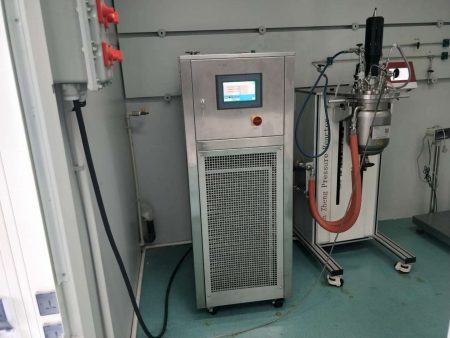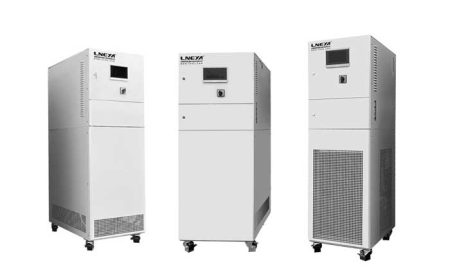Recirculating Water Cooling System
Contact us today for the perfect temperature control solution
The recirculating water cooling system is a method for heat dissipation. Its principle is to use water as a medium to quickly dissipate heat through circulation to achieve a cooling effect. This system is widely used in industry, aviation, military and other fields, and is also increasingly used by PC overclockers.
Composition of recirculating water cooling system
The recirculating water cooling system mainly consists of water pumps, cold radiators, water tanks, water pipes, flow meters, thermometers, refrigerants, insulation materials, etc.
The principle of recirculating water cooling system
A cooling water system that uses water as the cooling medium and circulates it. Mainly composed of cooling equipment, water pumps and pipelines. After the cold water flows through the production equipment that needs to be cooled (often called heat exchange equipment, such as heat exchangers, condensers, reactors), the temperature rises. If it is discharged immediately, the cold water is only used once (called a once-through cooling water system), so that the cold water can be heated up. After flowing through the cooling equipment, the water temperature drops back and can be pumped back to the production equipment for reuse. The consumption of cold water is greatly reduced, often saving more than 95%. Cooling water accounts for about 70% of industrial water consumption. Therefore, the cooling water circulation system plays a role in saving a large amount of industrial water.
The lower-temperature cooling water from the cooling tower is pressurized by the cooling pump and sent to the chiller. After taking away the heat of the condenser, the temperature rises, and then is sent to the cooling tower for spraying. Due to the cooling The rotation of the tower fan causes the cooling water to continuously exchange heat and moisture with the outdoor air during the spraying and falling process. The cooled water falls into the water collecting tray of the cooling tower and is then pressurized by the cooling pump again before entering the next stage. cycle.
Cooling equipment can be divided into open and closed types, so recirculating water cooling systems are also divided into open and closed types. Open systems are more complex to design and operate.

Open recirculating water cooling system
There are two types of cooling equipment: cooling pools and cooling towers, both of which mainly rely on the evaporation of water to reduce water temperature. Furthermore, cooling towers often use fans to promote evaporation, and the cooling water is often blown away. Therefore, the open recirculating water cooling system must be supplied with fresh water. The circulating water is concentrated due to evaporation, and the concentration process will promote salt scaling (see sediment control). Supplementary water has a dilution effect, and its flow rate is often determined based on the concentration limit of circulating water. Usually the amount of supplementary water exceeds the amount of water lost by evaporation and wind blowing, so some circulating water (called sewage) must be discharged to maintain the balance of water volume. recirculating water cooling system In an open system, due to the contact between water flow and the atmosphere, dust, microorganisms, etc. enter the circulating water; in addition, the escape of carbon dioxide and the leakage of materials in the heat exchange equipment also change the quality of the circulating water. For this reason, recirculating water cooling systems often require treatment, including sediment control, corrosion control and microbial control. The determination of the treatment method is often related to the quantity and quality of the make-up water, as well as the performance of the production equipment. When using multiple agents, possible chemical reactions between agents should be avoided.
Closed recirculating water cooling system
The closed recirculating water cooling system uses closed cooling equipment. The circulating water flows in the tube, and wind is usually used outside the tube to dissipate heat. Except for material leakage from heat exchange equipment, there are no other factors that change the quality of circulating water. In order to prevent salt scale in heat exchange equipment, sometimes the cooling water needs to be softened (see water softening). In order to prevent heat exchange equipment from being corroded, corrosion inhibitors are often added; pay attention to safety when using high-concentration, highly toxic corrosion inhibitors.
We provide complete temperature control systems design and manufacturing. From standard models to complete customized products up to 900 tons. We specialize in customer service and are dedicated to helping each customer have the optimal temperature control system for their specific need.
We provide non-standard customized solutions. Both single cooling chillers and cooling & heating combo units are available.
Email: info@lneya.com WeChat ID: +8615251628237 WhatsApp: +86 17851209193

Recirculating Chillers / Refrigerated Circulator
The chiller can be widely used in various industries and laboratories, and supports customized design.
| Temperature range | -25°C ~ +30°C series | -45°C ~ +30°C series | -60°C ~ -20°C series | -80°C ~ -20°C series | -120°C ~ -70°C series | ||||
| Cooling Capacity | 0.8 ~ 30kW | 0.75 ~ 12kW | 0.4 ~ 6kW | 0.2 ~ 6kW | 0.3 ~ 5kW | ||||
| Note: Any temperature range from -150℃ ~ +350℃ and any cooling capacity can be customized | |||||||||
 Water Chillers / Small Chillers
Water Chillers / Small Chillers
The chiller can be widely used in various industries and laboratories, and supports customized design.
| Temperature range | -18°C ~ +30°C | +5°C ~ +35°C series | |||||||
| Cooling Capacity | 0.35 ~ 0.9kW | 1.8 ~ 50kW | |||||||
| Note: Any temperature range from -150℃ ~ +350℃ and any cooling capacity can be customized | |||||||||

Low Temperature Chillers
We specialize in the production of low-temperature chillers with a temperature control range as low as -150°C, which can meet the refrigeration needs of different industries.
| Temperature range | -25°C ~ -5°C series | -45°C ~ -10°C series | -60°C ~ -10°C series | -80°C ~ -30°C series | -110°C ~ -50°C series | -150°C ~ -110°C series | |||
| Cooling Capacity | 12 ~ 360kW | 6 ~ 180kW | 6 ~ 180kW | 4 ~ 180kW | 2 ~ 120kW | 2.5 ~ 11kW | |||
| Note: Any temperature range from -150℃ ~ +350℃ and any cooling capacity can be customized | |||||||||

High Temperature Chillers
The chiller can be widely used in various industries and laboratories, and supports customized design.
| Temperature range | +5°C ~ +40°C | -25°C ~ +40°C | -45°C ~ +40°C | -80°C ~ +80°C | -100°C ~ +80°C | ||||
| Cooling Capacity | 6 ~ 40kW | 2 ~ 15kW | 1 ~ 8kW | 0.6 ~ 3kW | 1.5 ~ 3kW | ||||
| Note: Any temperature range from -150℃ ~ +350℃ and any cooling capacity can be customized | |||||||||

Cooling and Heating Chillers
Temperature Control Range: -120°C to +350°C
cooling and heating thermostat, widely used in various industry.
| Temperature range | -10 ~ +150°C series | -25 ~ +200°C series | -25 ~ +300°C series | -45 ~ +250°C series | -45 ~ +300°C series | -60 ~ +250°C series | -60 ~ +300°C series | -70 ~ +250°C series | -80 ~ +250°C series | -90 ~ +250°C series | -100 ~ +100°C series | ||
| Cooling Capacity | 1.5 ~ 15kW | 1 ~ 200kW | 1 ~ 200kW | 0.45 ~ 200kW | 0.9 ~ 25kW | 0.25 ~ 60kW | 0.75 ~ 25kW | 0.4 ~ 15kW | 0.3 ~ 80kW | 0.2 ~ 80kW | 0.45 ~ 80kW | ||
| Note: Any temperature range from -150℃ ~ +350℃ and any cooling capacity can be customized | |||||||||||||

Recirculating Heater Chillers
Temperature Control Range: -45°C to +250°C
| Temperature range | -25°C ~ +200°C series | -45°C ~ +250°C series | |||||||
| Cooling Capacity | 1 ~ 15kW | 0.25 ~ 15kW | |||||||
| Note: Any temperature range from -150℃ ~ +350℃ and any cooling capacity can be customized | |||||||||
 LNEYA
LNEYA
 简体中文
简体中文


















































































